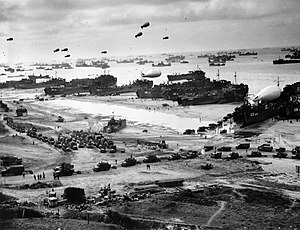| Operation Overlord | |||||||
|---|---|---|---|---|---|---|---|
| Part of the Western Front of World War II | |||||||
 LSTs with barrage balloons deployed, unloading supplies on Omaha Beach for the breakout from Normandy | |||||||
| |||||||
| Belligerents | |||||||
|
Axis | |||||||
| Commanders and leaders | |||||||
|
| ||||||
| Strength | |||||||
| Casualties and losses | |||||||
|
16,714 Allied airmen killed (8,536 members of the USAAF, and 8,178 flying under the command of the RAF) | |||||||
|
Civilian deaths: | |||||||
Operation Overlord was the codename for the Battle of Normandy, the Allied operation that launched the successful liberation of German-occupied Western Europe during World War II. The operation was launched on 6 June 1944 (D-Day) with the Normandy landings (Operation Neptune). A 1,200-plane airborne assault preceded an amphibious assault involving more than 5,000 vessels. Nearly 160,000 troops crossed the English Channel on 6 June, and more than two million Allied troops were in France by the end of August.
The decision to undertake cross-channel landings in 1944 was made at the Trident Conference in Washington in May 1943. General Dwight D. Eisenhower was appointed commander of Supreme Headquarters Allied Expeditionary Force, and General Bernard Montgomery was named commander of the 21st Army Group, which comprised all the land forces involved in the operation. The Normandy coast in northwestern France was chosen as the site of the landings, with the Americans assigned to land at sectors codenamed Utah and Omaha, the British at Sword and Gold, and the Canadians at Juno. To meet the conditions expected on the Normandy beachhead, special technology was developed, including two artificial ports called Mulberry harbours and an array of specialised tanks nicknamed Hobart's Funnies. In the months leading up to the landings, the Allies conducted Operation Bodyguard, a substantial military deception that used electronic and visual misinformation to mislead the Germans as to the date and location of the main Allied landings. Adolf Hitler placed Field Marshal Erwin Rommel in charge of developing fortifications all along Hitler's proclaimed Atlantic Wall in anticipation of landings in France.
The Allies failed to accomplish their objectives for the first day, but gained a tenuous foothold that they gradually expanded when they captured the port at Cherbourg on 26 June and the city of Caen on 21 July. A failed counterattack by German forces in response to Allied advances on 7 August left 50,000 soldiers of the German 7th Army trapped in the Falaise pocket by 19 August. The Allies launched a second invasion from the Mediterranean Sea of southern France (code-named Operation Dragoon) on 15 August, and the Liberation of Paris followed on 25 August. German forces retreated east across the Seine on 30 August 1944, marking the close of Operation Overlord.
- ^ a b Beevor 2009, p. 82.
- ^ Beevor 2009, p. 76.
- ^ a b Williams 1988, p. x.
- ^ Beevor 2009, p. 492.
- ^ Luxembourg Army website.
- ^ a b Meadows 2016.
- ^ Viganò 1991, p. 181.
- ^ Frittoli 2019.
- ^ Zetterling 2000, p. 408.
- ^ Badsey 1990, p. 85.
- ^ Zetterling 2000, p. 32.
- ^ Zetterling 2000, p. 34.
- ^ Shulman 2007, p. 192.
- ^ a b Wilmot 1997, p. 434.
- ^ Buckley 2006, pp. 117–120.
- ^ Pogue 1954, Chapter XIV, footnote 10.
- ^ US Army 1953, p. 92.
- ^ britannica.com.
- ^ Stacey 1960, p. 271.
- ^ Maczek 2006.
- ^ a b c Tamelander & Zetterling 2003, p. 341.
- ^ Tamelander & Zetterling 2003, p. 342.
- ^ Inman & Staines 2019, La Cambe German Military Cemetery.
- ^ SHAEF Weekly Intelligence Summary, No.51, w.e. March 11 PART I LAND Section H, Miscellaneous 3 Allied Achievements in the West
- ^ Tamelander & Zetterling 2003, pp. 342–343.
- ^ Zetterling 2000, p. 83.
- ^ Beevor 2009, p. 519.
- ^ Flint 2009, pp. 336–337.
Cite error: There are <ref group=lower-alpha> tags or {{efn}} templates on this page, but the references will not show without a {{reflist|group=lower-alpha}} template or {{notelist}} template (see the help page).